Cultural Diversity
board game
Practice - Emilio
Theory
Practice - Bibi
1) a piece of design/work made by a black queer person
2) a piece of design/work made by a public/community or does not have a clear author
3) a piece of design/work made by a minority in the country you live or grew up in
4) a piece of design/work made by someone who is not able-bodied
5) a memory, memorabilia, family, personal
Todrick Hall (born April 4, 1985) is an American singer, songwriter, choreographer, and YouTuber. He aspires to be a role model for LGBTQ and people of color, and includes his experiences as a Black gay man in his art.Many of his lyrics include elements of social commentary, such as racism, gun violence in and against black communities in "Water Guns" (featuring Jordin Sparks), acceptance of interracial relationships in "Color" (featuring Jay Armstrong Johnson), and queer culture.
Solomon Perel (also Shlomo Perel or Sally Perel; born 21 April 1925) is a German-born Israeli author and motivational speaker. He was born to a German-Jewish family and managed to escape persecution by the Nazis by masquerading as an ethnic German.
This is a painting done by a former patient of my mother. Even several decades after the therapy ended they kept in touch sporadically through telephone calls and visits. I only met her when I was around 7 years old, so I do not know to which extend she is limited in her movements, I only remember her sitting in a huge self-driving wheelchair.
I got this doll as a gift for my 4th birthday I think. Her name is Püppi, which basically derives from the german word for doll ("Puppe").
She was my favorite doll and I took her everywhere and even used her as a kind of pacifier while sleeping, hence the dark discolorations despite several attemtes to wash her.
homework week 38
homework week 39
In Germany it was common until the late 20th century for young women to have accumulated a basic set of goods for their future household by the time they got married, which they received as gifts or made themselves, like these embroidered linens made by my grandmother. These goods, known as trousseau or dowry, usually consisted of high-quality home textiles, dishes and other items required in the household ("trousseau quality"). The amount of the dowry depended primarily on the social position of the groom, which was supposed to effectively prevent women from lower social classes from marrying into higher classes without explicit prohibitions being required.
My grandmother was really good at doing all sorts of needlework and made me and my sister a lot of really cute sweaters and socks when we were young. One of her teachers encouraged her to become a needlework teacher, but my great-grandfather was against it as that meant she would have to live in a different city and would not be able to help her mother in the household.
I think my grandmother is still sad sometimes that she was never able to pursue this dream, as she often talk about this story and takes great pride in her skills.
When I moved out to study here in Rotterdam I got a lot of these tablecloths, towels, bedsheets and handkerchiefs from my mother and my grandmother. And even though I do not really use them regularly they do give me a certain feeling of being home, as they remind me of all the times we would decorate our home for the different seasons and festivities.
But as my grandmother is getting older and she is not really able to do this kind of work anymore I am a bit sad I never really learned these skills from her (I only know some basics).
Also sorry to my granny that these are so wrinkly, I don't own an iron :(
homework week 40 & personal research
Healing/Empowerment
Does the increasing number of people with mental health issues reflect a higher rate of psychological diseases or only an increasing awareness for mental health? And if it is indeed a growing issue which factors (in our society) influence this growth?
What does society label as “normal” vs “ill” -> H.G. Wells, “The Country of the Blind” (1925) -> normal/healthy as a synonym for conformity
“Sociological relativism, for which what is necessary for the existence and survival of a given society is good, is not at all as arbitrary as it appears. Indeed, from the standpoint of a given society, it is hard to imagine that this view would not come about. Because a society with a certain structure only exists as long as its members identify with an attitude that guarantees a more or less smooth functioning of this society.” - Erich Fromm, “The Pathology of Normalcy” (1953)
-> evolution of humankind is connected to a certain willingness to conformity, but also a certain degree of non-conformity/trying new things/evolving
We need a framework of reference and orientation/something we can devote ourselves to -> question of meaning of life
two types of work:
1)work as a liberating, emancipatory, development-enhancing power, coming from an inner necessity
2)work as a duty, hard labor in order to survive, is not fun and does not serve to find meaning (-> dreaming of not having to work some day)
What do we mean when we say we want to be happy? Being happy is an expression of intense liveliness. Pain and happyness belong together as a consequence of living intensly. The opposite of being happy is not being sad, it is not feeling anything (depression). Living intensely brings a kind of uncertainty. How do we get lost in a comfortable way? How do we prepare ourselves to the new and unknown?
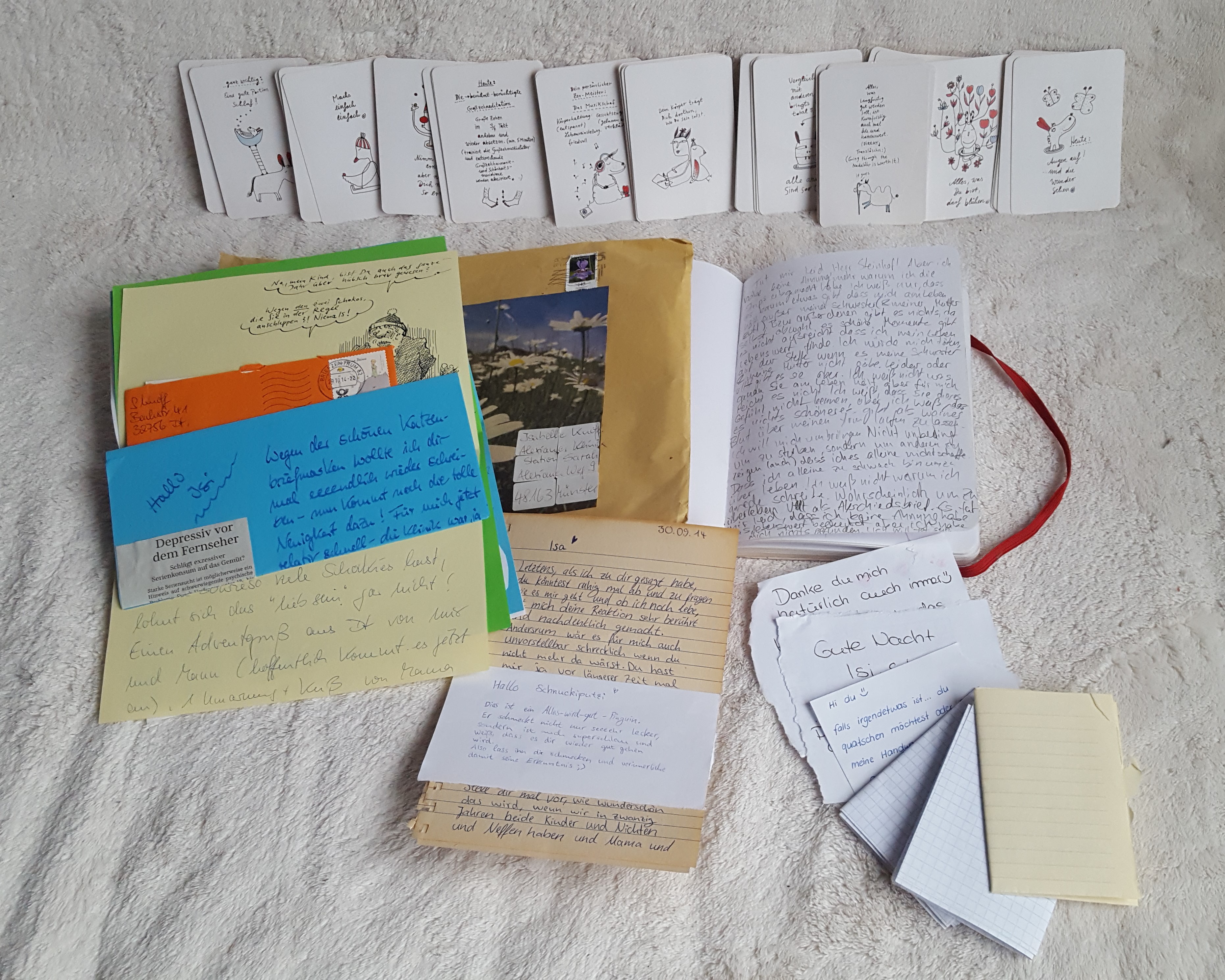
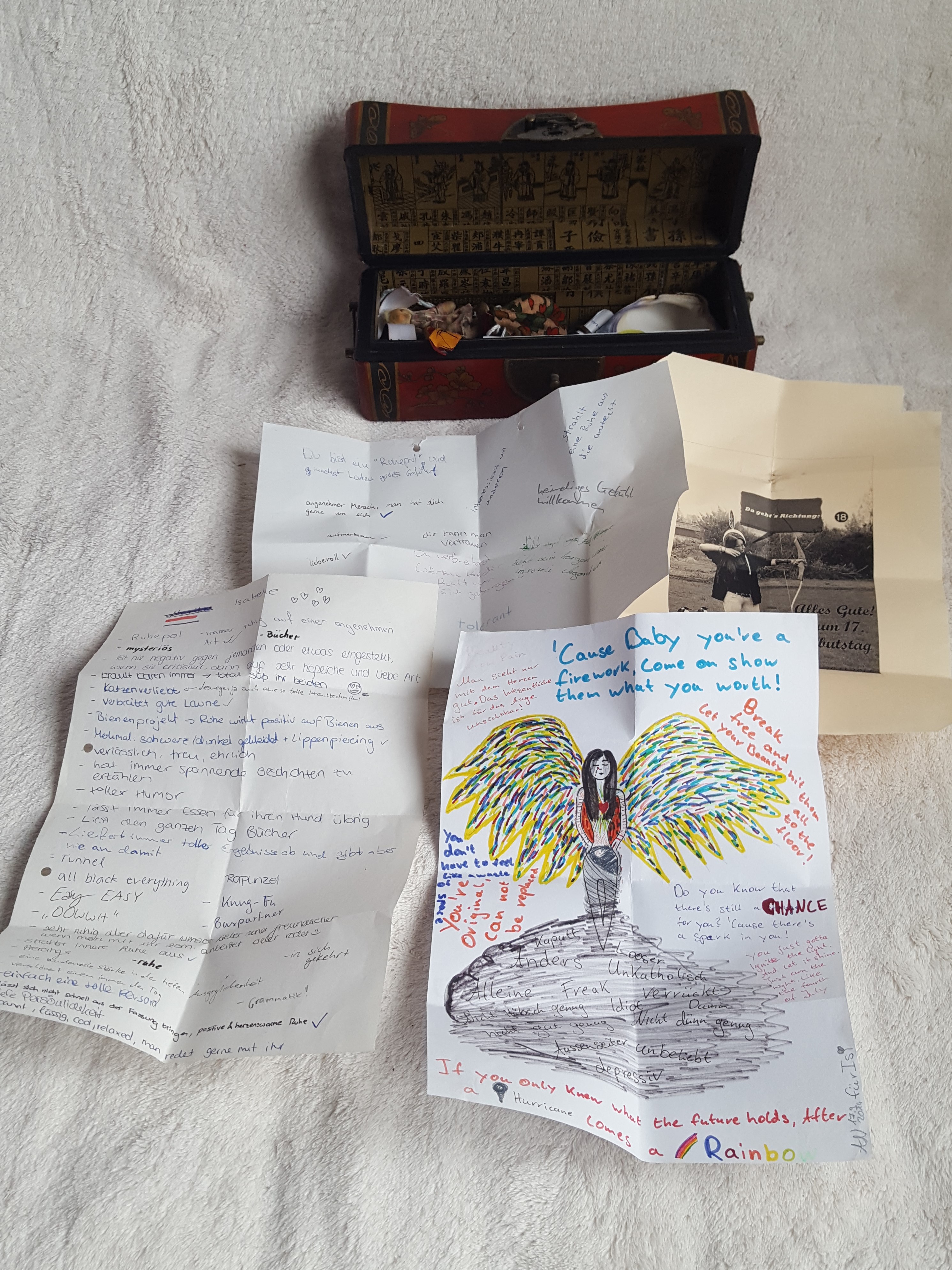


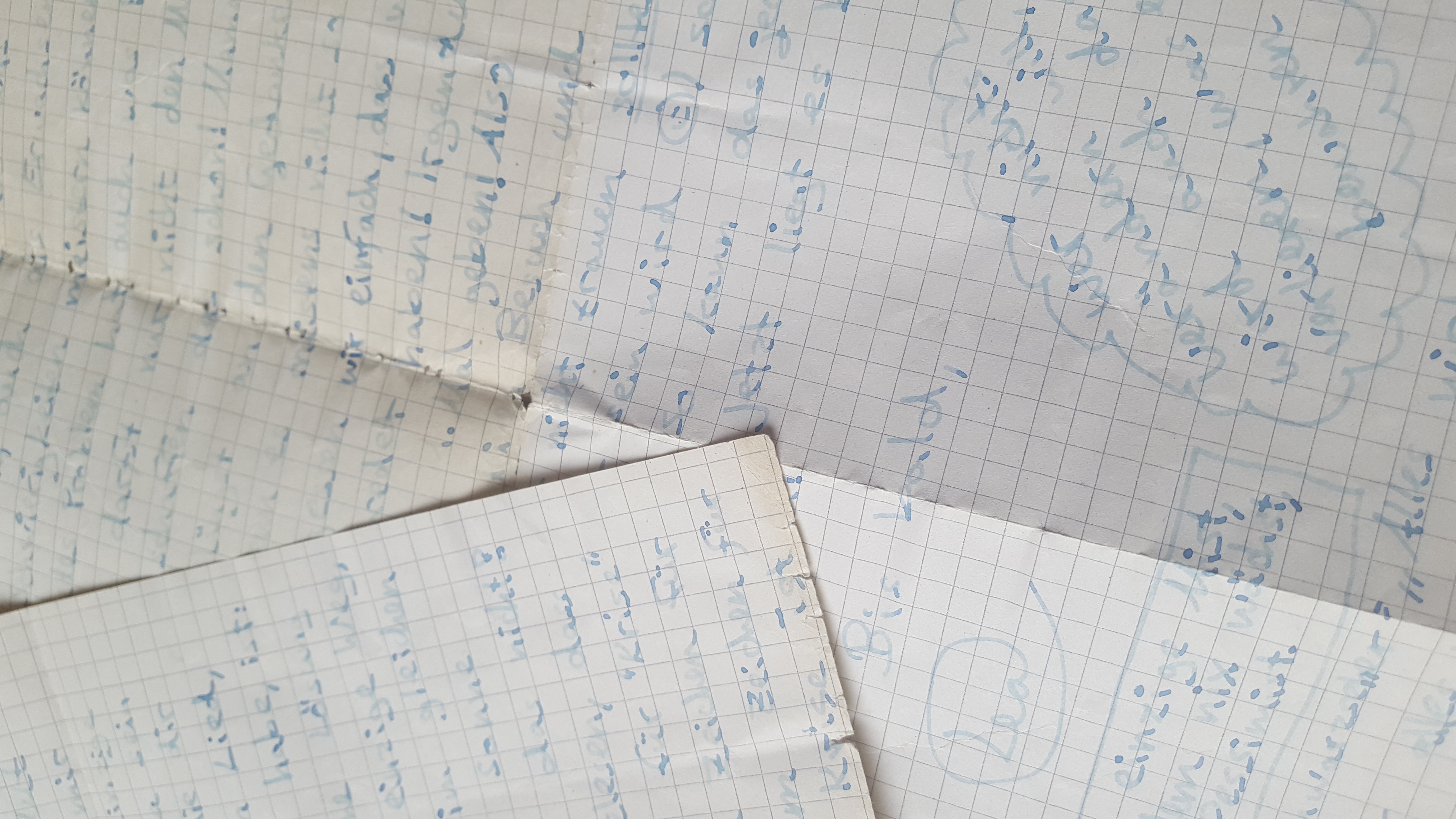
Letters etc from my time in a mental hospital
(trigger warning - self harm)
I hid my scars for quite a long time. In the mental hospital we were not allowed to show them at all. I understand that fresh wounds and scars can be triggering and that it also would have made us compare our scars and create this kind of competition among the patiens. My boyfriend at the time asked me how I was able to cut that deep and I remember asking myself the same thing about a friend.
My mother offered me to get them lasered, but that felt wrong to me. It would have brought back the urge to cut myself and it would feel like hiding a part from myself.
My scars never felt like a bad thing to me. They were the reason I was still alive, which might sound weird, but at that time they were my way of slowly letting out some pain instead of bottleing up my feelings until they would explode.
in 2017 I started counting my scars: 523 on my arm and neck at that point
my memory box
a letter from my sister from 2008 which I have hidden in my childhood pillow
Practice - Bibi
In school and from my father I was always told that I should become more outgoing and talk more. But my sister, who was talking more at home, was always told by my father to be quiet in order to let me talk (even though I did not want to).
But if everyone is talking, who listens?
- introverted people are often seen as shy and insecure, but that is not the same thing
- extroverted people can also struggle with social anxiety, which might show differently with them but should still be taken seriously
Only in recent years my relationship to me being introverted has slowly started to change.
I'm starting to see my quietness as a strength inside me. What has really helped me with that is an accepting environment around me. My friends value my calmness.
At the end of my highschool my class made a graduation newspaper magazine, in which we wrote texts about each other. For that we had sheets of paper going around in class where everybody could write down their feelings or memories with a person. I still have the sheets about me in my memory box and from time to time I take them out to read. It gives me such a warm feeling to see that others can see my introversion as something positive as well, and that it doesn't mean I am being overlooked for not being outgoing and talkative.
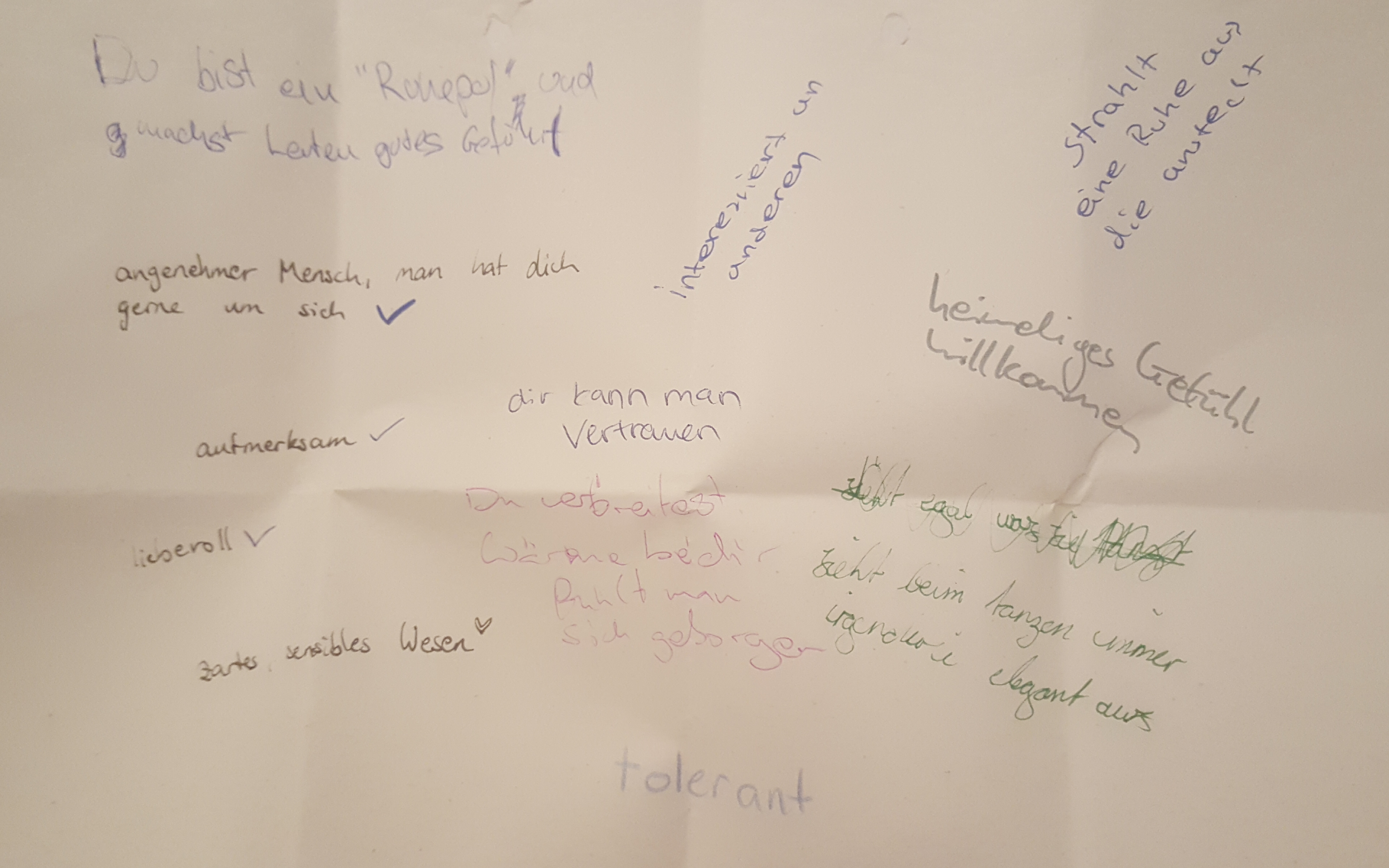
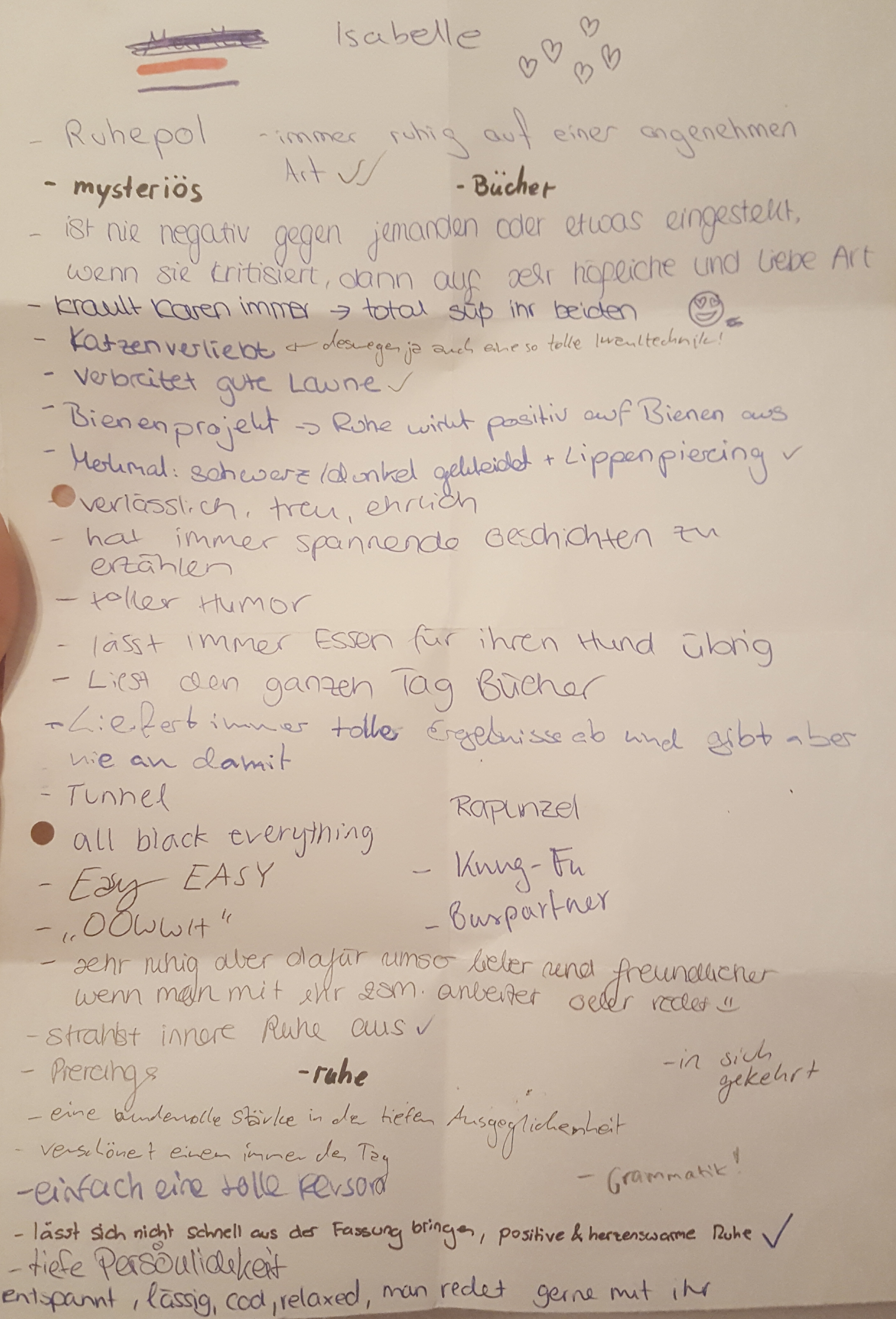
"Ruhepol" -> "oasis of tranquility"
"strahlt eine innere Ruhe aus die ansteckt" -> radiates an inner calm that is infectious
"lässt sich nicht aus der Fassung bringen, positive&herzenswarme Ruhe" -> can not be flustered/agitated, positive warm-hearted calmness